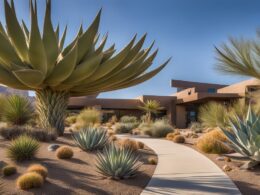Are you looking to create a beautiful and sustainable backyard? Incorporating native grasses into your xeriscape landscaping is a smart and eco-friendly choice. Not only do native grasses offer a variety of stunning foliage year-round, but they also provide numerous benefits for your outdoor space. From water savings to supporting wildlife habitats, native grasses are versatile additions that can transform your backyard into a vibrant and low-maintenance landscape.
When it comes to xeriscape landscaping, California is home to over 300 species of native grasses, making them perfect for any landscape style or preference. Whether you have a large garden or a small urban plot, these grasses can thrive in various environments and provide a natural, native charm to your backyard.
Key Takeaways:
- Native grasses for xeriscape landscaping offer numerous benefits, including water savings, low maintenance, and support for wildlife habitats.
- California is home to a wide variety of native grass species, providing versatility and adaptability to different landscape styles.
- Incorporating native grasses into your backyard can enhance the beauty of your outdoor space while conserving water and energy.
- With the right selection of native grass species and following low maintenance tips, you can create a sustainable and visually appealing landscape.
- Consider using design templates for native plant gardens to create personalized garden solutions that reduce water usage and maintenance.
Benefits of Native Grasses for Xeriscape Landscaping
Native grasses for xeriscape landscaping offer a multitude of benefits that make them an excellent choice for your backyard. These grasses are specifically adapted to the local climate and soil conditions, allowing them to thrive with minimal water requirements. By incorporating native grasses into your xeriscape design, you can enjoy the following advantages:
- Water savings: Native grasses have deep root systems that enable them to access water from deeper soil layers. This reduces the need for frequent watering and helps conserve water.
- Low maintenance: Once established, native grasses have minimal maintenance requirements. They are naturally resistant to pests and diseases, eliminating the need for chemical treatments. Additionally, their deep root systems help stabilize soil and reduce erosion.
- Summer-dry tolerance: California native grasses are well-adapted to the dry summers in the region. They can withstand prolonged periods of drought and maintain their green foliage even in the hottest months.
- Support for wildlife habitats: Native grasses provide valuable habitat and food sources for local wildlife, including birds, butterflies, and beneficial insects. They create a sustainable ecosystem that promotes biodiversity in your backyard.
- High carbon sequestration: Native grasses have the ability to absorb and store carbon dioxide from the atmosphere. By planting them in your xeriscape landscape, you can contribute to reducing greenhouse gas emissions and mitigating climate change.
Moreover, native grasses add aesthetic appeal to your landscape design. They offer a contrast in texture and form, with their loose structures and interesting leaf varieties. Whether you prefer a naturalistic wildflower meadow or a structured lawn alternative, native grasses can fulfill your design vision.
Native grasses stabilize soil, increase water infiltration, and recycle nutrients, making them ideal for urban environments and filtering polluted runoff.
Overall, incorporating native grasses into your xeriscape landscaping brings a range of benefits that go beyond water savings and low maintenance. They contribute to the health of your local ecosystem, help combat climate change, and create a visually stunning landscape that is both sustainable and inviting.
Nutrient Content of Native Grasses versus Traditional Lawns
| Native Grasses (per 100g) | Traditional Lawns (per 100g) | |
|---|---|---|
| Protein | 7.6g | 2.0g |
| Fiber | 12.6g | 2.8g |
| Vitamin A | 1010 IU | 230 IU |
| Vitamin C | 13.2mg | 4.9mg |
| Calcium | 54mg | 22mg |
| Potassium | 364mg | 250mg |
The table above compares the nutrient content of native grasses with traditional lawns. It highlights the superior nutritional value of native grasses, which provide higher levels of protein, fiber, vitamins A and C, calcium, and potassium.
By choosing native grasses for your xeriscape landscape, you not only create an environmentally friendly and low-maintenance space but also provide a healthier and more nutritious environment for your backyard ecosystem.
Featured Native Grass Species for Xeriscape Landscaping
When it comes to incorporating native grasses into your xeriscape landscaping, there are several featured species that can thrive in different conditions and add a touch of natural beauty to your backyard. These grasses are not only drought-tolerant but also support local wildlife and require minimal maintenance. Let’s take a closer look at some of these featured native grass species:
1. Bouteloua gracilis (Mosquito Grass)
A low-growing species, Mosquito Grass is perfect for hot and dry regions. Its delicate green foliage and graceful seed heads create a beautiful contrast in any landscape. This grass can withstand drought conditions and is ideal for areas with low foot traffic.
2. Festuca californica (California Fescue)
California Fescue is a medium bunchgrass that thrives in shaded or filtered light settings. Its deep green color and fine texture make it an excellent choice for borders, rock gardens, or as a ground cover.
3. Muhlenbergia rigens (Deergrass)
Deergrass is a stunning grass species that adds architectural interest to any xeriscape landscape. With its erect narrow blades and soft, airy texture, it provides a beautiful textural contrast. Deergrass is also an excellent habitat for birds and butterflies.
4. Leymus condensatus ‘Canyon Prince’ (Canyon Prince Wild Rye)
Canyon Prince Wild Rye is a compact blue-leaved grass that can tolerate both sun and shade. It forms dense clumps and creates a lush look in your landscape. This grass is perfect for erosion control on slopes or as a border plant.
5. Carex tumulicola (Foothill Sedge)
Foothill Sedge is a wispy and free-form grass that adds a naturalistic touch to meadows and open woodlands. Its fine-textured foliage and unique growth habit make it an excellent choice for creating a relaxed, native-inspired landscape.
6. Calamagrostis foliosa (Leafy Reedgrass)
Leafy Reedgrass is a perennial bunchgrass native to California. It features tall, arching stems with delicate seed heads, creating a graceful movement in the wind. This grass can be used as a focal point or to add vertical interest to your landscape.
7. Carex praegracilis (Field Sedge)
Field Sedge is a grass-like herb with triangular stems and dense flower spikes. Its unique form and vibrant green color add visual interest to moist or wet areas of your xeriscape landscape. This grass is also an excellent choice for rain gardens or along pond edges.
8. Carex testacea (Orange Sedge)
While not native to California, Orange Sedge can add striking color and movement to rock gardens and containers. Its vibrant orange-brown foliage creates a bold statement and complements other native grasses and plants in your landscape.
These featured native grass species offer a range of colors, textures, and growth habits that can enhance the beauty and sustainability of your xeriscape landscaping. Consider incorporating some of these grasses into your design to create a vibrant, low-maintenance landscape that is both visually appealing and ecologically beneficial.
Low Maintenance Tips for Native Grasses
Once established, California native grasses are low maintenance plants that can thrive with minimal care. Follow these tips to keep your native grasses healthy and vibrant:
- Water wisely: Native grasses are adapted to California’s Mediterranean climate and can withstand drought conditions. Water them sparingly, focusing on deep, infrequent watering rather than frequent shallow watering. Most native grasses can survive with little to no supplemental water once established.
- Avoid over-fertilization: Native grasses generally do not require fertilizers. Excessive nutrients can lead to excessive growth, which may reduce the lifespan and natural beauty of the plants. Instead, rely on the natural nutrients present in the soil.
- Mulch for moisture retention: Apply a layer of mulch around the base of the grasses to help retain moisture in the soil and suppress weed growth. Organic mulch, such as wood chips or straw, is recommended. Mulching also creates a favorable environment for beneficial microorganisms that improve soil health.
- Plant at the right time: Fall or early winter is the best time to plant native grasses. This allows them to establish a robust root system before the arrival of the dry summer months. Planting at the appropriate time increases the chances of successful establishment and promotes optimal growth and floral displays in the following seasons.
By following these low maintenance tips, you can enjoy the beauty of native grasses in your xeriscape landscape without the need for extensive care and maintenance.
Table: Native Grasses Low Maintenance Tips
| Tips | Description |
|---|---|
| Water wisely | Native grasses are adapted to drought conditions and require minimal supplemental irrigation. Deep, infrequent watering is preferable. |
| Avoid over-fertilization | Native grasses generally do not need additional fertilizers. Excessive nutrients can lead to excessive growth and reduced lifespan. |
| Mulch for moisture retention | Applying mulch around native grasses helps retain moisture in the soil, suppresses weed growth, and promotes beneficial microorganisms. |
| Plant at the right time | Plant native grasses in the fall or early winter to allow them to establish a healthy root system before summer droughts. |
Incorporating Native Grasses into Your Landscape
When it comes to transforming your landscape with native grasses, there are several factors to consider. Start by assessing the specific characteristics of your space, such as light conditions throughout the day and any existing wet spots. Dividing your site into smaller zones with similar conditions can help you choose the right native grasses for each area. Additionally, establishing a budget for your project will help guide your choices and ensure you stay within your desired investment.
Once you have a clear understanding of your landscape, you can begin selecting native grasses that suit your needs. Consider factors like shade or sun requirements, drought tolerance, and the ability to provide privacy or add visual interest. Native grasses can be planted in drifts and swaths to create a cohesive look, and it’s important to give them enough room to grow and thrive. You may also want to consider incorporating evergreen shrubs as a backdrop to add structure and enhance the overall aesthetic of your landscape.
By incorporating native grasses into your landscape, you are not only creating a visually appealing outdoor space but also supporting the environment. Native grasses are well-suited to the local climate and require less water and maintenance compared to non-native species. They also provide important habitat and food sources for local wildlife, contributing to the overall biodiversity of your backyard. So, whether you’re aiming to conserve water, attract pollinators, or simply enhance the beauty of your landscape, incorporating native grasses is a sustainable and rewarding choice.
Design Templates for Native Plant Gardens
Bloom! California offers a variety of design templates that can help you create stunning native plant gardens. These templates are like “recipes” that provide guidance on different styles and purposes, such as creating shady refuges, sunny pollinator patches, privacy hedgerows, pots and planters, linear strips and swales, and welcoming entries. By following these templates and using resilient and reliable native California plants, you can create a beautiful habitat for birds and butterflies while reducing water usage and maintenance.
Whether you have a small backyard or a large garden, these design templates can be easily adapted to fit your space. They are suitable for any size of green space and can be combined or used individually to create customized garden solutions. You can choose templates based on your specific needs and preferences, whether you want to attract specific wildlife, create a specific ambiance, or maximize water conservation. These design templates provide a practical and accessible way to incorporate native plant gardens into your landscape.
Examples of Bloom! California Design Templates:
- Shady Refuges: Create a peaceful oasis with various shade-loving plants that thrive in low-light conditions.
- Sunny Pollinator Patches: Attract bees, butterflies, and hummingbirds with a colorful array of nectar-rich flowers.
- Privacy Hedgerows: Use tall, dense native shrubs and grasses to create a natural barrier and enhance privacy.
- Pots and Planters: Beautify your patio or balcony with container gardens filled with drought-tolerant California native plants.
- Linear Strips and Swales: Convert narrow strips of land or swales into functional and attractive rainwater management features.
- Welcoming Entries: Create an inviting entrance to your home with a mix of native plants and eye-catching design elements.
With Bloom! California’s design templates, you can transform your landscape into a vibrant and sustainable native plant garden. These templates offer step-by-step guidance and inspiration, making it easier for you to incorporate native plants into your outdoor space. By following these templates, you can create a beautiful and ecologically beneficial garden that enhances the natural beauty of your surroundings.
How Can I Incorporate Native Grasses Into My Xeriscape Landscaping?
When looking to embrace xeriscape conversion with native species, consider incorporating native grasses into your landscaping. Native grasses are well-suited for xeriscaping as they require minimal water and maintenance while adding natural beauty to your outdoor space. Incorporating these grasses can enhance the sustainability and aesthetic of your landscape.
Conclusion
Incorporating native grasses into your xeriscape landscaping not only enhances the beauty of your backyard but also helps conserve water and energy. California native grasses offer numerous benefits, including water savings, low maintenance requirements, support for wildlife habitats, and high carbon sequestration.
By selecting the appropriate native grass species and following low maintenance tips, you can create a sustainable and visually appealing landscape. Whether you choose featured grass species or utilize design templates, incorporating native grasses into your landscape is a sustainable choice that benefits both you and the environment.
With their ability to thrive in hot, dry conditions, native grasses provide a beautiful and ecologically friendly alternative to traditional lawns. By reducing water consumption, minimizing the need for pesticides, and supporting wildlife, native grasses play a vital role in creating a more sustainable future for our landscapes.
So, why wait? Start exploring the world of native grasses for xeriscape landscaping and transform your backyard into an oasis of beauty and sustainability today.














